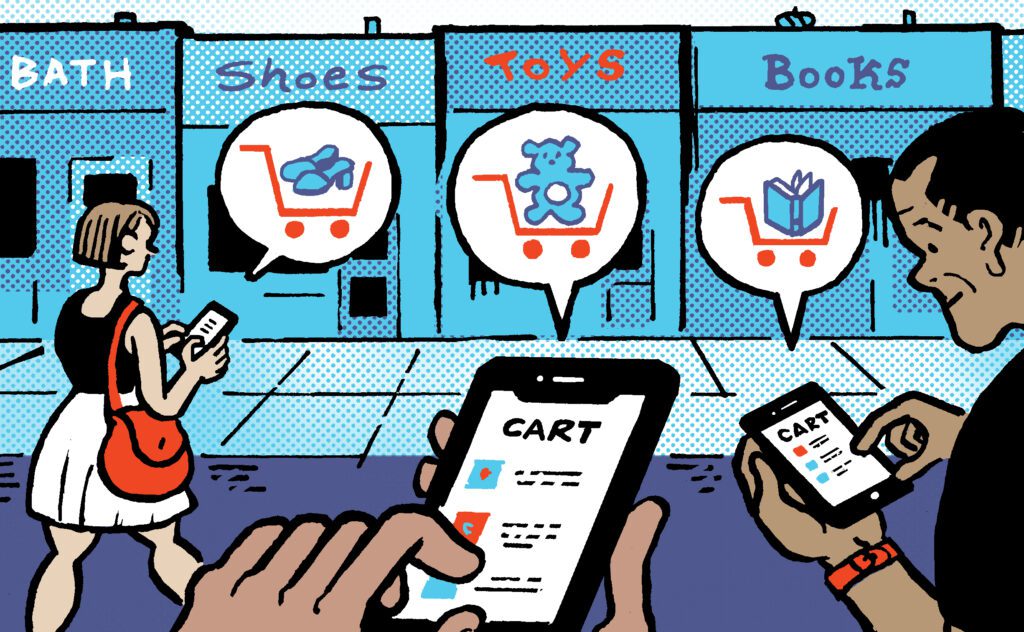Hey readers, welcome to the AdExchanger Commerce weekly, where we have the news and trends marketers need to know in the new world of shopping.
And speaking of shopping, the results are in: The five big shopping days between Thanksgiving and Cyber Monday were a smash hit.
Or so the story goes.
Retailers were preparing for a downturn this season. But Adobe’s online sales tracker registered 7% growth on Black Friday and a more than 9% annual increase on Cyber Monday – which, at $12.4 billion, was the biggest ecommerce day yet in America.
Shopify also clocked a record-high $9.3 billion over the shopping weekend.
Despite pessimism going into the holiday season, record online spending across Cyber Week “shows the impact that discounts can have on consumer demand,” said Vivek Pandya, a lead analyst for Adobe Digital Insights.
Emphasis on “discounts.”
The cheapening
Earlier this month, this newsletter examined how retailers and major ad platforms are tilting the market toward discounts for sellers to reach their shopper audiences.
Advertising and product pricing are opposite sides of the same coin, which begs the question: To reach a new customer, are you better off spending another dollar on advertising or dropping your price by $1?
This holiday season, the major ad platforms have been signaling they want to see strong discounts more so than additional paid media (while not discouraging brands to spend a ton on ads, too, obviously).
One of the already simmering frustrations for Amazon product sellers this season is the platform’s strict rules hindering third-party sellers from getting the badge that indicates an item is on sale.
Amazon doesn’t trust that a seller is actually offering a discount when it allegedly advertises a sale. To be sure, Amazon tracks the on-platform price over time to make sure deals are actual deals, and it also scours the web to check that the product is not listed for less elsewhere.
Notably, these rules don’t apply to products sold directly by Amazon.
So, how have prices been trending?
Last year, Adobe’s seasonal sales tracker increased across practically all goods, albeit primarily on overall price inflation. This year, discounts were at all-time highs for apparel, consumer electronics, furniture, sporting goods and other verticals.
Average order volume was up a modest 3%. But that isn’t enough to account for the high weekend sales of $12.4 billion. Sellers achieved high overall sales despite heavy discounting because net new shoppers made their holiday purchases online this year, largely driven by discounts, according to the Adobe report.
Checks out. Common Thread Collective, an ecommerce ad agency, has observed a 10.8% gain in net new customer purchases. Yet new customer revenue is still down because those average order values have dropped.
 The money pits
The money pits
The unmentioned forces this year that have rocked online holiday advertising – if not holiday shopping overall – are the Chinese ecommerce apps Shein and Temu.
There isn’t a crowded long tail of retail media sellers that compete for Google product listing ads and in Meta shopping auctions, said Etsy CEO Josh Silverman, speaking at the Needham Consumer Tech and Ecommerce Conference earlier in November.
Anna Andreeva, an ecommerce analyst for Needham, asked him whether Temu’s and Shein’s rapid market share gains affect Etsy.
“They are growing very quickly, of course, and they’re taking share pretty broadly across lots of ecommerce players,” Silverman responded.
But the biggest impact from both, he said, is that they’ve cut out the retail marketplace long tail – which you might say starts with eBay (trailing far behind Amazon) and includes the likes of Etsy, Macy’s and Wayfair.
On the one hand, Temu and Shein dominate the competition on pricing in a way that simply can’t be matched. Which is why Shein and Temu merch is perennially listed atop Google shopping searches.
Even Amazon, which is notoriously rigorous about combing the web to make sure sellers don’t list the same items for less on another site or app, simply stopped including Temu marketplace items beginning this summer.
As Silverman told investors on Etsy’s earnings report last week, Temu seemingly has no ROI thresholds or expectations of profitable growth. So Etsy can’t compete with Temu on Temu’s own turf – which is to say, on price. Etsy can focus on what distinguishes its marketplace from Temu.
Temu and Shein are “single-handedly” affecting the cost of shopping ads on Google and Meta. And with unbeatable low prices, the platform algorithms already favor Temu and Shein.
There’s nothing Etsy or any other seller can do about it, at least until Temu rationalizes its prices and ad budgets. (The company is losing billions of dollars per month and has a broader market impact than Shein, which focuses on clothes.)
Well, there is actually one thing that other marketplaces can do.
Silverman mentioned at the Needham conference that one of Etsy’s earliest AI-related product releases is an internal tool that finds items on its marketplace that are also sold on Temu – and removes those items.
It remains to be seen who gets the last laugh.

















